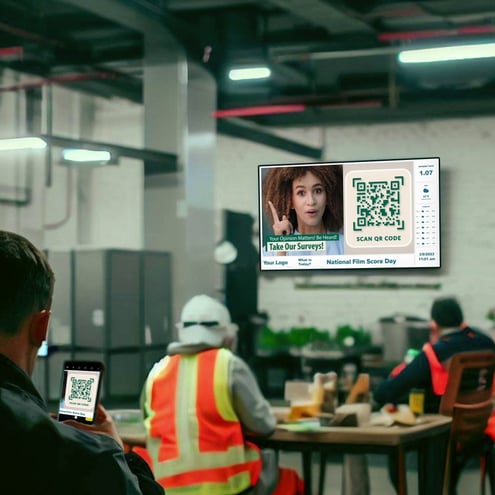Enhance employee engagement and communication by incorporating QR codes into your digital signage.
Why QR Codes are Essential for Digital Signage
QR codes are essential for digital signage because they provide a convenient and efficient way to access information. By displaying QR codes on your digital signage, you can link to various forms and notifications, such as employee feedback surveys, near-miss forms, shift swap requests, and inventory notifications. This makes important information easily accessible to employees, increasing their engagement with the content and encouraging their participation in events.
Additionally, QR codes can help streamline communication in a manufacturing facility. Instead of relying on traditional methods such as paper forms or emails, employees can simply scan the QR code to access the relevant information or submit a request. This saves time and reduces the risk of miscommunication.
Furthermore, QR codes can be easily updated and customized to fit the specific needs of your manufacturing facility. Whether you need to add new forms or notifications or modify existing ones, you can do so seamlessly by updating the QR codes displayed on your digital signage. This flexibility ensures that the information provided remains relevant and up-to-date.
Benefits of Using QR Codes on Digital Signage

Using QR codes on digital signage in a manufacturing facility has several benefits. Firstly, QR codes make information easily accessible to employees. Instead of searching for paper forms or navigating through multiple digital platforms, employees can simply scan the QR code to access the desired information or submit a request.
Secondly, QR codes enhance employee engagement. By displaying QR codes on digital signage, employees are more likely to engage with the content and participate in events. The convenience of scanning a QR code encourages active involvement and interaction, leading to increased employee engagement and improved communication.
Thirdly, QR codes improve efficiency and streamline communication. Instead of relying on manual processes or complex digital systems, employees can quickly access the information they need by scanning a QR code. This saves time and reduces the risk of errors or miscommunication, resulting in a more efficient and effective workplace.
Lastly, QR codes provide valuable data and insights. By tracking the usage of QR codes, you can gather data on employee engagement, preferences, and behaviors. This data can be analyzed to identify trends, improve communication strategies, and make informed decisions to enhance employee engagement and communication.
Best Practices for Implementing QR Codes on Digital Signage
When implementing QR codes on digital signage, it is important to follow best practices to ensure optimal effectiveness and user experience. Here are some best practices to consider:
1. Clear and visible placement: Ensure that the QR codes are displayed prominently on the digital signage and easily visible to employees. This will encourage them to scan the QR codes and access the information or submit requests.
2. Concise and descriptive labels: Provide clear labels or instructions next to the QR codes to explain what information or action the QR code will lead to. This will help employees understand the purpose of the QR code and encourage them to engage with it.
3. Regular updates: Keep the QR codes updated with the latest information and forms. Regularly review and update the content linked to the QR codes to ensure that employees have access to relevant and up-to-date information.
4. Testing and feedback: Before implementing QR codes on a large scale, conduct testing and gather feedback from a sample group of employees. This will help identify any potential issues or improvements that can be made to enhance the user experience.
By following these best practices, you can maximize the effectiveness of QR codes on digital signage and ensure a positive user experience for your deskless workforce.
Successful Examples of QR Code Integration in Digital Signage
There are several successful examples of QR code integration in digital signage in manufacturing facilities. Here are a few examples:
1. Employee feedback surveys: By displaying QR codes on digital signage, employees can easily access and complete feedback surveys. This allows for real-time feedback collection and helps improve communication between employees and management. Additionally, a deskless worker is less likely to log onto the company intranet when they are at home. QR codes allow employees to quickly access information from the breakroom, cafeteria, lobby, etc.
2. Near-miss forms: QR codes can be used to link to near-miss forms, allowing employees to report any potential safety incidents or hazards quickly. This promotes a proactive approach to safety and helps prevent accidents in the workplace.
3. Shift swap requests: Employees can use QR codes to submit shift swap requests instead of going through a manual process or contacting multiple colleagues. This simplifies the process and improves efficiency in managing shift changes.
4. Inventory notifications: QR codes can be used to provide employees with real-time inventory notifications. By scanning the QR code, employees can instantly access information about inventory levels, allowing for better planning and decision-making.
These examples demonstrate how QR codes on digital signage can effectively enhance communication, engagement, and efficiency in a manufacturing facility.

Innovative Developments: QR Codes Shaping the Future of Digital Signage
QR codes continuously evolve and shape the future of digital signage in manufacturing facilities. Here are some innovative developments in this field:
1. Dynamic QR codes: Instead of static QR codes, dynamic QR codes are becoming more popular. Dynamic QR codes can be updated in real-time, allowing for dynamic content and personalized employee experiences.
2. Integration with mobile apps: QR codes can be integrated with mobile apps to provide a seamless user experience. Employees can simply scan the QR code using their smartphones to access the information or submit requests, eliminating the need for additional hardware or devices.
3. Analytics and data-driven insights: QR codes are not only a means of accessing information but also a valuable source of data and insights. By tracking the usage of QR codes, manufacturing facilities can gather data on employee behavior, preferences, and engagement levels. This data can be analyzed to identify trends, improve communication strategies, and enhance the overall employee experience.
4. Interactive digital signage: QR codes can be used to create interactive digital signage experiences. For example, employees can scan a QR code to participate in quizzes, contests, or training modules. This gamification approach enhances engagement and provides a fun and interactive way to communicate important information.
These innovative developments highlight the potential of QR codes in shaping the future of digital signage and communication in manufacturing facilities.